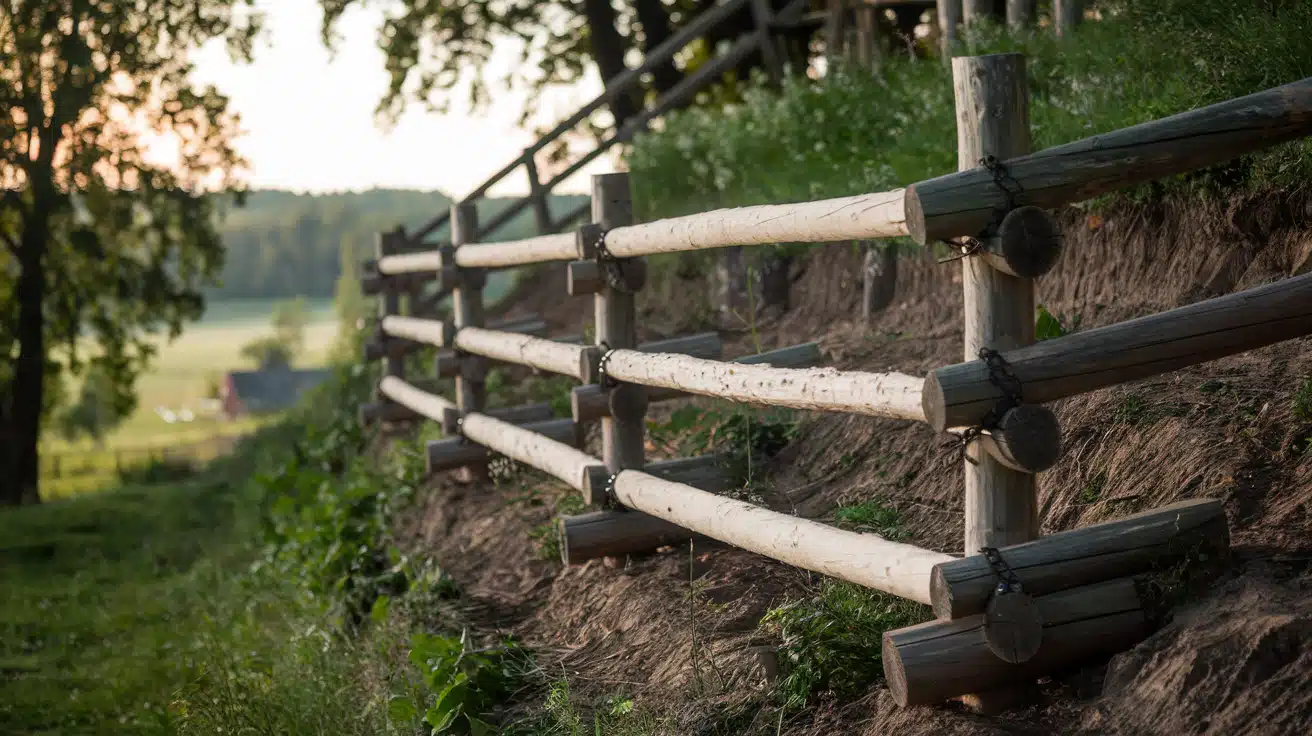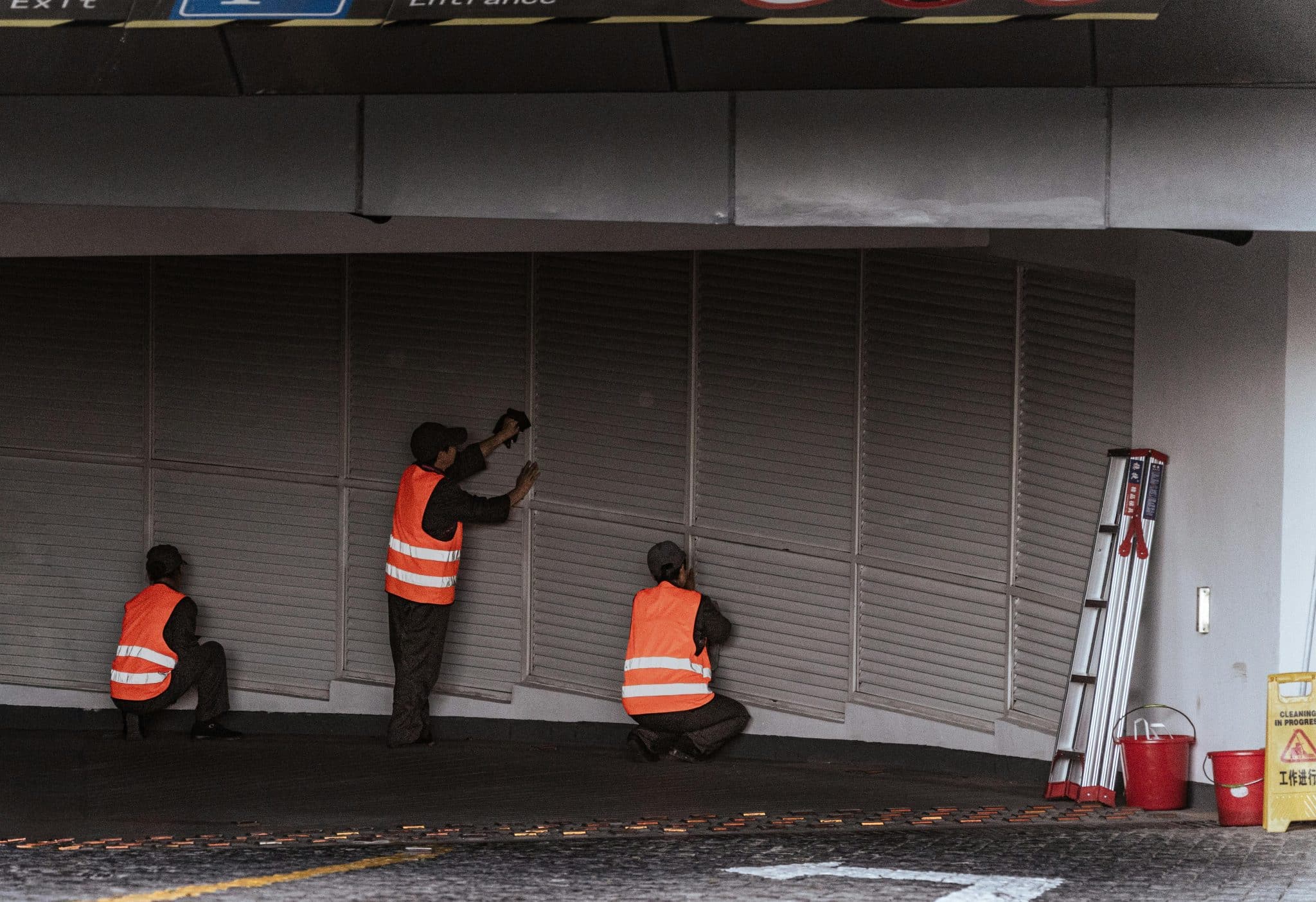Building a fence on a slope presents real challenges for many homeowners. Standard fence on slope ideas don’t sit right on hills, leaving awkward gaps or uneven tops that look out of place.
But there’s good news – with the right approach, your sloped yard can have a beautiful fence that works with the land, not against it. From stepped wooden designs to flexible chain link and even living hedges, you have many options to solve this common problem.
This guide will provide practical fence on slope ideas for sloped yards. You’ll learn which materials work best on hills, how to pick the right style for your needs, and what to consider before starting your project.
Whether you’re looking for privacy, safety, or simply a stylish way to mark your boundary, you’ll find solutions that fit your yard’s unique landscape.
For more inspiration on building your own privacy fence, check out these creative DIY ideas.
What is the Best Way to Fence a Sloped Yard?
Putting up a fence on a slope presents unique challenges. Uneven ground makes standard fencing methods tough to use. You might face issues like gaps at the bottom or uneven tops that look odd.
Rackable fences work well for gentle slopes. These adjust to the land with panels that follow the hill. For steeper hills, stepped fencing is often better. This method keeps fence panels level while posts change height.
Fencing slopes offers benefits like better water flow and less soil loss. It can also highlight your yard’s natural shape. However, it costs more than flat ground fencing and often requires more skill to build.
When picking a fence for your slope, consider these key points: what it’s made of (wood bends, metal lasts), how much you can spend (stepped fences cost more), privacy needs (solid vs. see-through), and how steep your land is.
Getting these right makes a huge difference in how your fence looks and works.
Slope Fence Ideas to Upgrade Your Outdoor Space
From stylish privacy fences to nature-inspired designs, these slope fence ideas offer smart solutions to transform tricky landscapes into beautiful, functional spaces.
1. Stepped Wood Fence
Stepped wood fences keep each panel level while following the hill’s angle. This creates a neat, stair-like look that works well on steep land. The wood brings warmth to your yard and can be stained to match your home’s style.
Why It Works: It creates clean lines on tricky hills
Best For: Steep slopes with dramatic changes in height
Care Tip: Apply wood sealer yearly to prevent rot
2. Racked Metal Fence
This fence style bends with your land’s natural shape. The metal bars adjust to the slope without creating gaps. Its simple design fits modern homes and needs little upkeep compared to wood options.
Why It Works: Follows land curves without steps
Best For: Medium slopes with a clean, current look.
Care Tip: Check for loose parts after winter months
3. Horizontal Slat Fence with Level Tops
These fences use long wooden boards placed side by side. The tops line up perfectly while the bottoms follow the ground. This creates a smooth, neat fence line that looks fresh and current.
Why It Works: Creates an even top line across uneven ground
Best For: Homes with a simple, modern style
Care Tip: Leave small gaps between slats for water drainage
4. Gabion Retaining Wall Fence
Wire cages filled with stones make a strong, useful fence. They hold back soil while marking your yard’s edge. The stones let water pass through, which helps stop wet soil problems on hills.
Why It Works: Stops soil loss while marking boundaries
Best For: Areas that need both a fence and soil support
Care Tip: Fill with local stones to blend with your setting
5. Stone and Iron Combo Fence
Stone posts paired with iron rails offer both strength and style. The stone bases stay firm on slopes while the metal parts between them allow for changes in ground height.
Why It Works: Mixes sturdy base with flexible top sections
Best For: Homes with a touch of old-world charm.
Care Tip: Check iron parts for rust after rainy seasons
6. Split Rail Fence on a Curve
This simple fence, with its crossbar style, follows your land’s shape. It marks your space without blocking views or feeling too solid. The posts can be set at different heights to match the ground.
Why It Works: Simple to build on changing ground
Best For: Country homes or large yards
Care Tip: Space posts closer on steep sections for more support
7. Woven Bamboo Fence on Uneven Terrain
Bamboo poles woven together make a fence that bends with your yard’s shape. This green choice works well on slopes since it can be bent and shaped more than solid wood panels.
Why It Works: Bends and flexes with the land
Best For: People who want earth-friendly options.
Care Tip: Treat with oil to extend life in wet spots
8. Lattice Panel Fence with Varying Heights
Lattice panels, with their cross-pattern, provide both privacy and airflow. They can be cut to match slope changes and still look planned and neat.
Why It Works: Easy to trim to fit sloped ground
Best For: Gardens where you want some plant view
Care Tip: Paint all cut edges to stop water damage
9. Natural Hedge Fence for Slopes
Living plants form a green wall that grows with your land’s shape. Shrubs like boxwood or yew can be trimmed to make a neat edge along slopes and hills.
Why It Works: Grows into the perfect shape for your land
Best For: People who want a green, soft border.
Care Tip: Pick plant types based on your slope’s sun level
10. Chain Link Fence with Greenery Cover
Basic chain link can be put up on any slope. Adding vines or climbing plants hides the metal and adds beauty. This mix gives you safety plus good looks.
Why It Works: Easy to install on any ground type
Best For: Yards where pets or kids need a safe space.
Care Tip: Train plants to climb evenly for best cover
11. Retaining Wall with Built-in Fence
Low walls that hold back soil can have fence parts added on top. This two-job fix works great on steep spots where soil might move down the hill.
Why It Works: Stops land shifts while adding height.
Best For: Very steep slopes that need firm support.
Care Tip: Add drain holes in the wall to let water out
12. Railroad Tie Fencing with Staggered Heights
Old train track beams make strong fence posts. Set at changing heights, they create a firm fence line that steps down your hill in a planned way.
Why It Works: Heavy enough to stand firm on steep ground
Best For: Big yards with a raw, basic style.
Care Tip: Check if your area allows these (some don’t)
13. Picket Fence with Asymmetrical Steps
The classic white picket can also work on slopes. By stepping down in small bits, it keeps its charm while solving the slope issue.
Why It Works: Keeps the loved picket look on uneven ground
Best For: Homes with a sweet, homey style
Care Tip: Use high-grade paint to cut down touch-up work
14. Modern Vertical Metal Rod Fence
Thin metal rods placed close together make a neat fence that works on slopes. The posts can be set at changing heights while the rods stay straight up.
Why It Works: Sleek look works with today’s home styles.
Best For: Small yards that need a light visual touch.
Care Tip: Pick coated metal to avoid rust issues
15. Rustic Log Fence Following the Terrain
Round logs laid side by side create a fence with a wood charm. The logs can be cut at angles to sit flush with sloped ground, making a solid barrier.
Why It Works: Natural look fits wooded lots
Best For: Cabins or homes with a forest feel
Care Tip: Set logs on small stones to avoid ground rot
16. Terraced Fence Sections with Planters
Built-in plant boxes between fence parts let you grow flowers on your slope. The boxes hold soil flat while the fence steps down the hill.
Why It Works: Adds growing space to your fence line
Best For: People who want to mix plants with fencing.
Care Tip: Line boxes with plastic to keep wood dry
17. Glass Panel Fence with Metal Posts
Clear glass panels between metal posts keep views open while marking space. The posts can be set at exact heights to match your slope while panels stay level.
Why It Works: Keeps hill views clear and open
Best For: Yards with great views to keep
Care Tip: Use treated glass that won’t spot in rain
18. Reclaimed Pallet Fence on a Gradual Incline
Old shipping pallets can be used to make cheap fence panels. Their size is suitable for stepping down mild slopes, and they can be painted to look fresh.
Why It Works: Low-cost option using items often thrown away.
Best For: People who like to make things themselves.
Care Tip: Sand rough spots to avoid splinters
19. Brick and Wood Accent Fence
Brick posts set firmly in the ground support wooden panels between them. This mix gives the fence strength at key points while wood parts can be cut to match the slope.
Why It Works: Strong base with parts that can be custom cut
Best For: Homes where you want a bit of class
Care Tip: Seal where wood meets brick to stop rot
20. Wire Mesh Fence with Wood Frames
Fine wire mesh held by wooden frames makes a light fence that’s hard to see. The frames can be built to match your hill’s exact shape.
Why It Works: Almost clear while still secure.
Best For: People with pets who want low visual impact
Care Tip: Check for sharp wire edges that might hurt pets
21. Cedar Shadowbox Fence with Variable Heights
This fence style has boards on both sides with small gaps between them. The boards can be cut at the bottom to follow your slope while the tops stay even.
Why It Works: Looks good from both sides of the fence
Best For: Yards where you see the wall from inside and out.
Care Tip: Let cedar age to silver or stain it for color
22. Artistic Mosaic Stone Fence
A low wall made with stone pieces in a pattern adds art to your yard. It can be built to follow ground changes while making a strong style point.
Why It Works: Turns a plain fence into a yard feature
Best For: Front yards where looks matter most
Care Tip: Set stones in good mortar to handle freeze cycles.
Fence Material Considerations on Slopes
- Wood (Stick-Built): Very easy to cut and fit to any slope shape with simple tools.
- Wood (Pre-made Panels): Works best with stepping methods rather than trying to tilt the panels.
- Vinyl: Some panels can rack slightly, but most need stepping for slopes over 10 degrees.
- Aluminum/Ornamental Steel: Great for slopes since many styles have joints that pivot to match ground changes.
- Chain Link: Follows almost any slope naturally and costs less than other options.
- Composite: Often needs stepping like vinyl since most panels are rigid with limited bend.
Pros and Cons to Know Before Fencing a Sloped Yard
| Pros | Cons |
|---|---|
| Creates privacy even on uneven land | Installation is more complex than on flat ground |
| Prevents soil erosion and adds support | Higher labor and material costs |
| Enhances landscape aesthetics | Requires careful measurement and customization |
| Offers security for pets and kids | May need retaining walls or added drainage |
| Variety of design options available | Not all fence styles work well on steep slopes |
Conclusion
Choosing the fence on slope ideas for a sloped yard takes careful thought but pays off with great results. A well-built wall on a hill not only marks your land but also adds style to your outdoor space.
Remember to match your fence to your yard’s specific slope type.
Gentle slopes might work with racked panels that follow the land. Steeper hills often need stepped designs that keep panels level.
Remember to consider the fence’s material. Wood offers flexibility, vinyl offers low upkeep, and metal provides strength.
Your choice should fit both your yard’s needs and your home’s look. Before you start, check local rules about fence height and placement. You might need permits, especially for fences that also hold back soil. Take your time with this project.
Frequently Asked Questions
1. What is the Cheapest Fence Option for a Sloped Yard?
Chain link is the most wallet-friendly choice that naturally follows slope curves.
2. Do I Need Special Tools to Build a Fence on a Slope?
You’ll need a good level, post hole digger, and saw that can make angled cuts.
3. Can I Put up a Fence on a Steep Hill Myself?
For slopes over 15 degrees, hiring pros is often wiser to avoid costly mistakes.
4. How do I Stop Water from Damaging My Fence on a Hill?
Add small drainage channels under the fence and use water-resistant materials.






























